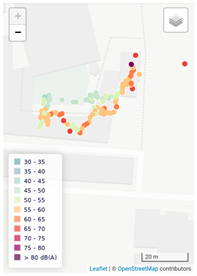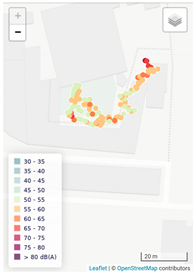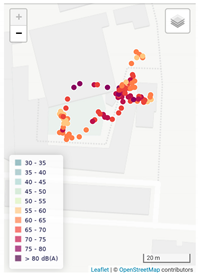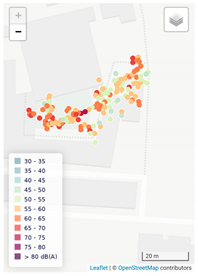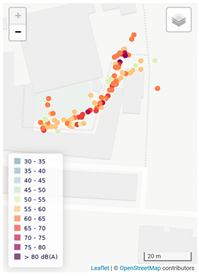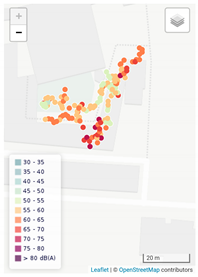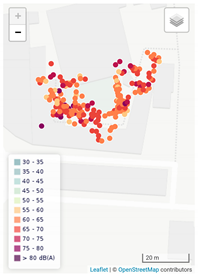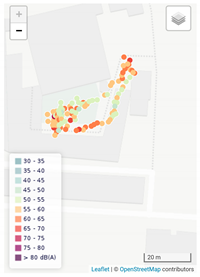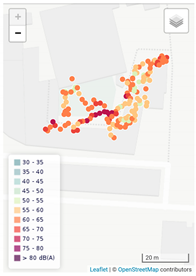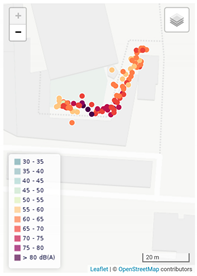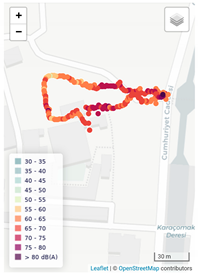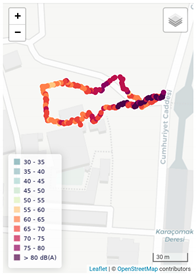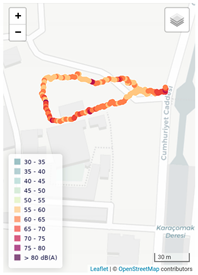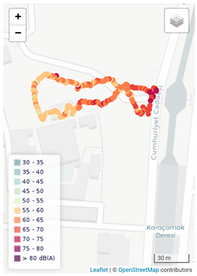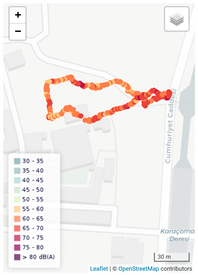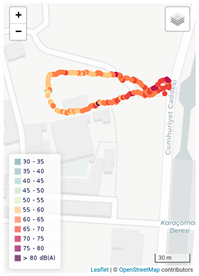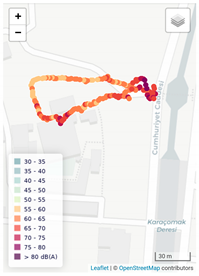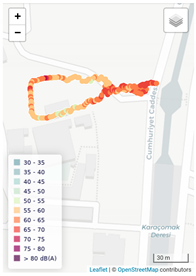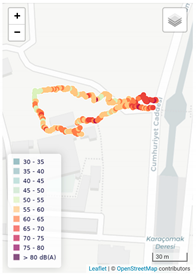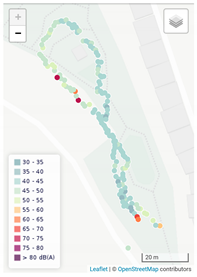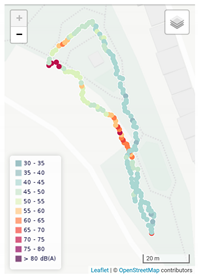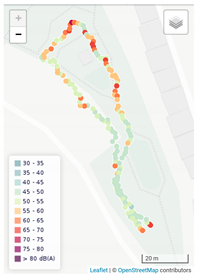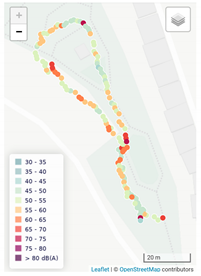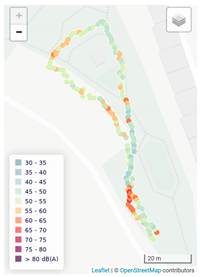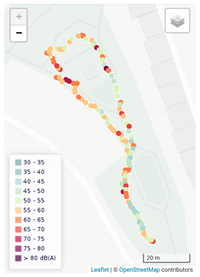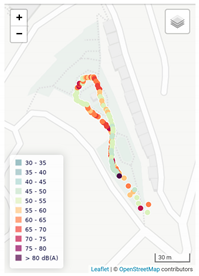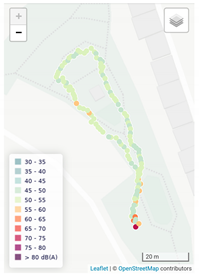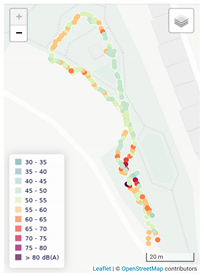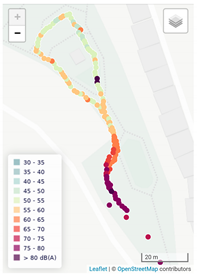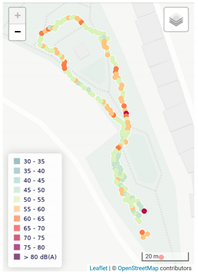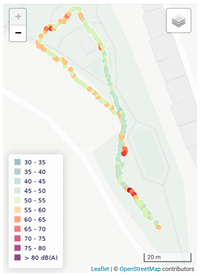Abstract
The general aim of this paper is to demonstrate the significance of the acoustic environment in urban historical places, which represent intangible cultural heritage, and to emphasize the need for the spaces to have their own unique acoustic environment depending on their characteristics. Both sound pressure level measurements and sound classifications were conducted in three urban historical places to emphasize their effect on the character of the area. Based on the data obtained, noise maps were created. The results of the study indicated that there was no change in sound sources due to the similarity of past and present usage types of the three selected historical areas, and that sound sources as an element of cultural heritage in the area were preserved and survived to the present day as a consequence. The type of use, intensity of use, structural-plant density, and climatic change were found to be effective in determining the acoustic environment character. The continuity of sound sources, which are among the elements that constitute the identity in historical places in particular and can be considered as cultural heritage elements, and the harmony of these sound sources for the intended use of the space are the factors that should be taken into account in spatial planning and design.
1. Introduction
Historical urban areas have been shaped by generations through space and time, so they are unique with natural and cultural assets [1]. The accumulated and stratified production of living cultures adds social, cultural, and economic value to historical urban areas. In this stratification, in addition to the natural features, such as topography, geomorphology, and hydrology of the area, the historical and cultural features, such as land use, built environment, tradition, and sensory features (auditory, olfactory, visual), also have an important role. However, the increasing population and the change in environmental conditions require the change and transformation of these features and areas alike. This change and transformation also reveal the danger of the disappearance of historical sites. The UNESCO recommendation on the historical urban landscape emphasizes that preservation has to move beyond the physical environment and focus on the entire human environment with all its tangible and intangible qualities [2]. This approach aims to increase the sustainability of planning and design interventions by taking the existing built environment, intangible heritage, cultural diversity, socio-economic and environmental factors, and local community values into account. However, with the principle of sustainable development, it may be possible to protect, use, and pass on historical sites to future generations [3]. Sound environments that emerge depending on the physical and cultural elements of urban historical areas and their surroundings are also one of the important heritage values that have survived from the past to the present and perhaps can be passed on to future generations. The change of historical areas and their surroundings also brings about a change in the sound environment that occurs in these areas. These changes are sometimes in line with the values of the historical area, while some other times there may be very contrary auditory environments. The intertwining of different uses, especially in urban areas, and the fact that historic urban centers are often in the middle of these uses leads to a combination and sometimes conflict of different sound environments. Garrioch [4] stated that the voices heard in European cities in the 17th, 18th, and 19th centuries were different from those heard today, and that the sound, at that time, was a very important source of information for people who flee from the noise of the city today. He notes that sound creates identity, and that the change in sounds over time actually contains information that helps to understand the change of urban areas. Additionally, sound could help users to establish the sense of a place [5].
In order to get to know more about a historical urban area, it is important to listen to the sounds in the area where the historical place is located, and to determine the sound sources [6]. The sounds determined offer clues about time, space, and society [4]. These clues, on the other hand, can play a leading role in determining the character of the space, thus providing an important source of information for planners [7]. Sounds also contain signs of events, situations, and movements for those who live in the city. For example, the sound of wind and the sound of rain provide information about the weather, the sounds of bell and adhan (prayer calls) about the time of worship, the school bells and factory sirens about the start and end of a workday. In addition, sound provides information about the lifestyles, attitudes, customs, and traditions of societies. For example, in European cities, the quiet demeanor of the elites is perceived as polite, while the noisy attitude is perceived as impudent, and it is considered unacceptable for men to speak and laugh louder than women do [4]. While the loudness of the human voice is the very nature of life in the Middle East countries [8], it is strange that the voices of women are heard more than men, especially in daily life. While being silent in religious places is an acceptance coming from traditions, at the same time, the silence in these places plays a role in keeping the worshipers alone with themselves and with the God. Therefore, the sound intensity in the space both provides the user with clues about how to behave and reflects the character of the space.
With the modernization and mechanization in urban life over time, especially in historical city centers, mechanical sounds that are not connected with the past are gaining importance. Voices that have remained the same over time and have survived to the present day also exist, which enable us to understand historical urban acoustic environments in particular. Especially the prayer sounds heard from places of worship show continuity without changing over time. While these sounds enable us to learn about cultures, on the other hand, when cultural differences occur, a sound that is meaningful for one society may not contain a feeling for another [6].
The concept of the acoustic environment, defined as the whole of natural and human-produced sounds reaching the human ear in a specific area that varies according to environmental factors, emerged as the sonic environment with the work of Southworth in 1969 and became more known after Schafer’s work in 1977 [9]. Unlike those on noise management and control, in studies related to the acoustic environment, sound has been evaluated as an element that defines the space, and thus reveals the character of it [10,11]. In defining the character of the space according to auditory features, unlike sound pressure level measurements used in physical planning and design studies, it is necessary to classify the sounds in these measurements, to examine their harmony with the character of the space, and to focus on environmental factors [12]. In addition, the auditory comfort of the users should also be taken into consideration when determining the auditory characteristics of any given space. Because, when the sound pressure level in the environment reaches an undesirable level, users are adversely affected both physiologically and psychologically. They experience impaired concentration, communication problems, and learning difficulties [13]. This issue becomes even more important, especially in urban areas where human use and cultural landscape features are the most intense, leading to different sound sources.
Studies have so far been conducted on the acoustic environment and, in particular, on the definition of the acoustic environment in historical urban areas [1,4,5,6,7,8,9,11,14,15,16,17,18,19,20,21,22,23,24]. With this study, we aimed to emphasize the control of the sound level in historical areas and its effect on the character of the area. Today, historical areas are not generally controlled in terms of protection from noise, and it is thought that the permitted noise standards in these areas are not exceeded. From another point of view, the character should be seen as an important value as well as the sound level in the protection of historical sites. Considering that these areas are exposed to intense human use due to activities, such as tourism, SPL (sound pressure level) measurements offer important data for planners and site managers to support the conservation of historical sites and affect planning and management decisions about these historical sites. With this aspect, the study emphasizes the importance of SPL measurements in the planning and management of historical sites.
In this study, by focusing on the sound sources and environmental factors of three urban historical places with different characteristics, SPLs were measured. Thus, factors to be considered in terms of sound characteristics in the planning and design of these areas were determined. Data regarding climate and area characteristics for the periods during which the measurements were made were collected. In line with the data obtained, noise maps were created. By determining the sound types and sound levels in sample areas, the study aimed to establish their relationship with the type of field use, and therefore with the character of the field. The study focused not on user preferences and perception, but on the sound sources and sound levels detected in spaces, and on the reasons for change in them over time.
2. Materials and Methods
2.1. Study Area
The study was carried out in 3 historical sites with different purposes of use located in the protected urban site in the city center of Kastamonu, a former settlement in the Western Black Sea region, in northern Turkey (N:41.3766, E:33.7765). Münire Madrasah, one of the important commercial centers in the city, Nasrullah Square, which is located in the center of the city with different uses, and the Clock Tower, which is located in the east of the city on one of the highest points, were selected as study areas in the study. In choosing these areas as study areas, attention has been paid to the fact that (i) these areas appeal to the vast majority of people living and visiting the city, (ii) the past and present uses of the areas have similarities and differences, and (iii) these areas have different types of use and therefore different types of sounds. Information on the location of the study areas is given in Figure 1.
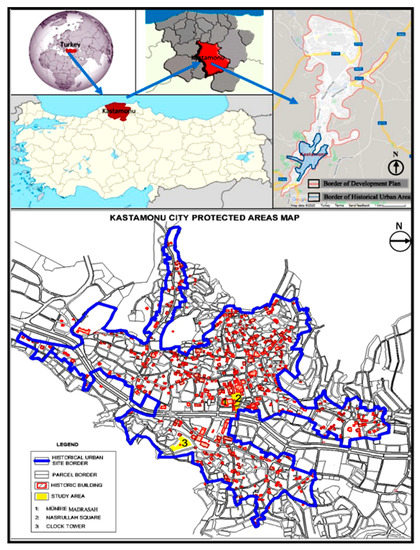
Figure 1.
Location map of study areas [25].
Kastamonu city is located in Northwest Anatolia Region of Turkey. Kastamonu city center is surrounded by forested passive green spaces and open and green areas making up 14% of the land in city center [26]. Settlements were constructed along the Karaçomak stream, which flows through the city with an axis. A continental climate dominates in the city center. According to the data from the Turkish Statistical Institute (TSI), the population of Kastamonu city center was 152,553 in 2019 [27]. The number of visitors in 2019 was 393,316 domestic and 6704 foreigners in total [28]. Kastamonu possesses an ancient history, and archaeological excavations and surface explorations indicate that the settlement in the region dates back to Paleolithic, Neolithic, and Chalcolithic periods and to early Bronze Age uninterruptedly [29]. The city is one of the rare settlements in Turkey that has survived to this day with its historical texture being undisturbed, and in this respect, it attracts tourists at different times of the year. The city, which was designated the cultural capital of the Turkic World in 2018, has 564 immovable cultural assets. The majority of the registered civil architecture building stock of the Western Black Sea region is also located in the city center [30]. Located in the provincial borders, Mahmutbey Mosque has been included in the world heritage tentative list. In addition, works are underway to include the city in the UNESCO creative cities network in the field of gastronomy.
- 1.
- Münire Madrasah
Built in 1746 as an educational complex, the one-story stone masonry building, and its courtyard were restored in 1988. The complex was used as a student dormitory after the restoration, and in 2001 it was opened for tourism and became a trading house where local craft products have been marketed since then. There are 21 shops within the complex [31] (Table 1).
- 2.
- Nasrullah Square
Located in the city center, the Square consists of a mosque with the same name, a fountain and commercial units located in and around it. There is also a bridge over Karacomak Stream, which passes through the city, connecting the square with the main road. Built in 1506, the bridge, the fountain, and the mosque constitute the important historical structures of the city and are among the places that both locals and tourists use extensively in the city today. Religious buildings and commercial buildings in the square cause the Square to be used at all hours of the day [32] (Table 1).
- 3.
- Clock Tower
The tower, which is located at one of the highest points of the city, is one of the important landmarks of the city. The Clock Tower, built in 1885, still rings every hour today. In addition, the seating areas around the Clock Tower, which is located at a point that dominates the city, are used by the locals and tourists at all hours of the day as it also offers food and drink facilities while watching the city [33] (Table 1).

Table 1.
General properties of the study areas.
Table 1.
General properties of the study areas.
| Münire Madrasah | 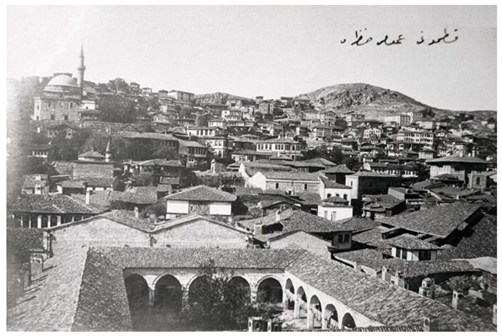 Source: [34] | 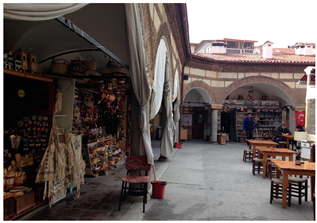 | |
| Period | Past 1900s | Present 2000s | |
| Function | Education | Commercial, Tourism | |
| Nasrullah Square | 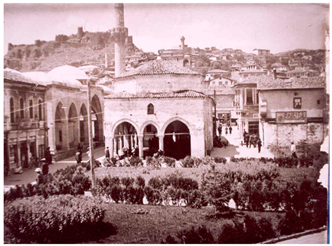 Source: [35] | 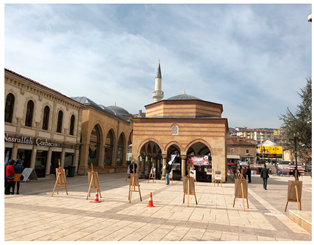 | |
| Period | Past 1900s | Present 2000s | |
| Function | Religious, Commercial, Recreation | Religious, Commercial, Recreation, Tourism | |
| Clock Tower | Past | Present | |
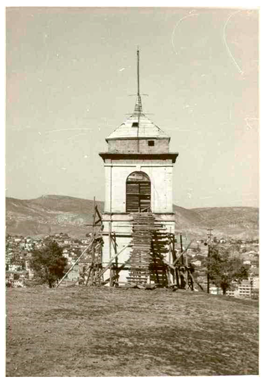 Source: [33] | 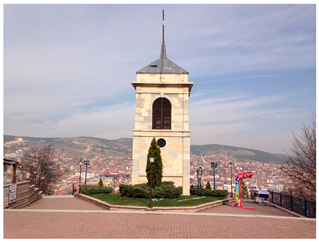 | ||
| Period | Past 1900s | Present 2000s | |
| Function | Recreation | Tourism, Recreation | |
2.2. Method
This study aimed to draw attention to the fact that sound characteristics have an important place in character identification of historical areas. For this purpose, by determining sound types and sound levels in sample areas, the study attempted to associate them with the use of an area and to determine whether they are compatible with the character of the space. Sound levels were measured in study areas, with a focus on listening to the acoustic environment. In this method, in addition to the sound pressure level spatially, the relationship of the sound source with the characteristics of the space was determined [36].
Walking routes were primarily determined in each study site. Attention was paid to creating routes to travel the entire site and best reflect the characteristics of the sites (in terms of daily activities and sound sources). In 2018–2019, walks were performed during the summer (June–July) and winter (February–March) seasons on weekdays and weekends in the morning (08:30), at noon (12:00), and in the evening (18:00) on days without heavy rainfall or wind, and a total of 36 measurements were made. Since the study areas are in an urban environment, measurements were started and finished especially at the hours when the intensity of human activities started (08:30) and ended (18:00). Since the characteristics and sizes of the 3 selected study areas differ, the measurement time was also different in the three areas. The measurement times were determined as an average of 3 min (65 m) for the Münire Madrasah, 10 min for the Nasrullah Square (250 m), and an average of 13 min (320 m) for the Clock Tower.
SPL measurements are one of the basic quantitative methods for determining acoustic comfort [19,37,38]. Noise maps are created especially in areas with special characteristics in cities (parks, squares, and historical areas) [22,39]. Therefore, the NoiseCapture program [40], operated via a smartphone, was used to measure and identify the sound and create the noise maps. The researcher who performed the walk also used the SVAN 957 model noise measurement device in order to compare the sound pressure level (SPL), which was measured via a smartphone.
SPL measurements are generally based on “Weighted Equivalent Continuous Sound Level” (LAeq), which gives the temporal average of the sound level in dB(A) [21,41]. The World Health Organisation (WHO) recommends guideline levels of 55 dB(A) outdoor for daytime sound levels [13] (Table 2). In addition, if there are more than one sound source and background sounds in a place, it is evaluated in the most frequently used statistical values (L10, L50, L90) since only evaluating with LAeq will not provide sufficient information [15]. While L10 gives an average measure of high-level and short-term sounds, L50 indicates the mid-sound level and the sound level exceeded for 50% of the time, and L90 indicates the sound level exceeded for 90% of the time [42]. Within the scope of the study, evaluations were made on the LAeq, L10, L50, and L90 values obtained in the SPL measurements of the areas, and observation forms regarding the sounds measured by the WHO according to the characteristics of each space were also filled (Table 2).

Table 2.
Guideline values for community noise in specific environments [13].
In the observation form, such climatic data as the air temperature and wind conditions, as well as sound types and perceived dominance levels are included (Table 3). Special attention was paid to make the walk the same speed in all areas, while the duration of the walk differed depending on the length of the walking routes. Attention was paid to the fact that the sound sources identified in the measurement areas were heard frequently during the measurement period in the space, and that they were detected in every measurement, and these sounds are defined as continuous sounds. In addition, since some sound sources are specific to the area or certain times of the season/day (adhan sounds, bell sounds, leaf sounds, bird sounds), the definition of such sound sources was also made and these sounds were defined as periodic sounds.

Table 3.
Climatic data for the study area.
Noise maps make it possible to determine whether the current sound environment violates the current limit values, and to identify the level of influence of a certain area or the areas exposed to the sound [43]. The measurement results were transferred on digital maps with the NoiseCapture program, and noise maps of each space were obtained. In the evaluation process, observation forms and sound measurements were analyzed together, which made it possible to associate the instantaneous and regional sound pressure levels in the human ear with the characteristics of the physical space.
3. Results
By means of observations and measurements made in the study areas, sound sources and SPLs of these sources were determined and then noise maps were created using SPLs detected along the walking route.
3.1. Sound Sources
3.1.1. Münire Madrasah
The main sound sources were identified through the walk on a 65-m-long route in the study area (Table 4). When examining the changes in sound sources over time, it was determined that the human voice, although it appeared to vary in intensity, was the most dominant sound type in the space, especially from 09:00 in the morning when the Madrasa began to be used until 18:00 in the evening when it was closed. The area, which was used for educational purposes in the past, is now used for commercial and touristic purposes, and this situation has not caused any change in the human voice, which is the main sound source.

Table 4.
Sound types and properties of the study areas.
3.1.2. Nasrullah Square
During the walk on the 250-m-long route, it was determined that there were both human-produced and natural sounds in the Square (Table 4). In terms of temporal change, it was determined that the traffic sound, speech sound, and footsteps from human-produced sounds showed continuity in the Square. Likewise, due to the fountains and water pools located in the area, the water sound from natural sounds showed continuity as well. However, it was determined that the water sound was heard more clearly in periods of low intensity of human activities (morning-evening) or when the water source was approached. In the time period during working hours (08:30–18:00) when human activities are intense, the voices of the vendors in the trading houses around the Square, the sound of the music played in the shops or in the Square depending on the activities held from time to time, and the sounds from the religious rituals heard at certain times of the day from the places of worship located in the Square were defined as the human-produced sounds that were heard periodically. In the religious structure, the adhan (call to prayer) is recited five times a day for about 2 min through a loudspeaker. The sound intensity shows instantaneous increases during these periods. Especially during the period when the plants in the Square are leafy (spring-summer-autumn), it is possible to hear the sounds of birds in the morning and evening when the Square is not crowded. Sound sources have not changed as the purpose of use of the Square is the same as in the past, but only the sound of traffic has become dominant due to the increase in its intensity of use.
3.1.3. Clock Tower
As a result of the measurements made along the 320-m-long walking route in the recreation area around the Clock Tower, which is located on a hill overlooking the city, it was determined that there were both human-produced (speech sound, bell sound, music sound) and natural sounds (atmospheric sounds) in the area (Table 4). The sound of bells ringing every hour in the area and the sound of speech in the resting area, the sound of music, and the sound of wind caused by climatic events were also detected periodically. The speech sounds of those who use the seating units located around the Clock Tower can be heard, especially when approaching the seating units. While there is no difference between the former use of the Clock Tower and its current use, the seating areas built later around the tower have increased the usage density around the tower, thus increasing the human-produced sound in the sound sources. However, since human-produced sounds are not louder than natural sounds, natural sounds can be heard more comfortably in the Clock Tower.
3.2. Sound Pressure Level
3.2.1. Münire Madrasah
When the values obtained as a result of the walks performed in the Münire Madrasah were evaluated in regard to periods, in terms of sound pressure level in winter measurements, the highest value was 93.2 dB at noon on weekdays and the lowest value was 44.0 dB in the morning on weekdays, whereas the highest value in summer was 84.3 dB in the evening on weekends, and the lowest value was 45.7 dB in the morning on weekdays (Table 5). Accordingly, the highest value of the sound pressure level for the Madrasa was obtained at noon on weekdays during the winter period, and the lowest value of the sound pressure level was obtained in the morning on weekdays during the winter period. Although the average SPL was determined to be above the WHO-recommended 50 dB(A), especially due to the constant human activities carried out in the area with tourists arriving on tourist tours at certain hours, it was determined to be below the 70 dB(A) level, which is expressed for trade areas and which causes hearing impairment (Table 2). Depending on the historical and conservation status of the area, although the sound level in the environment was not at the desired level, when evaluated in terms of usage (trade and tourism), the values remained at the normal level.

Table 5.
SPL of study areas.
3.2.2. Nasrullah Square
According to the sound pressure level measurements carried out in Nasrullah Square, it was determined that the highest value in the winter period was 82.4 dB at noon, and the lowest value was 50.4 dB on the weekend. The highest value in the summer period was detected to be 96.1 dB at noon on weekdays, and the lowest value to be 52.9 dB in the morning on the weekend (Table 5). Accordingly, the highest sound pressure level value in summer was obtained at noon on weekdays, while the lowest value of the sound pressure level in the Square was obtained in the evening at the weekends in winter. Although the average SPL was determined to be above the 50 dB(A) recommended by WHO, it was determined that the level of 70 dB(A) expressed for trade areas in Table 2 and which causes hearing impairment was only exceeded at noon during the weekdays in summer. The Square is located in the center of the city and serves as an important gathering, meeting, resting, worship, trade, and transit area. In addition, due to the fact that the main artery of the city passes right next to it, it was determined that the SPL, which was detected at 70 dB(A), was at an acceptable level according to Table 2, especially considering that it did not show 24-h continuity.
3.2.3. Clock Tower
According to the measurements carried out in the Clock Tower, the highest value in the winter period was 93.0 dB in the morning of the weekend and the lowest value was 41.8 dB in the evening of the week, whereas the highest value in the summer period was 77.8 dB in the morning and evening of the weekend and the lowest value was 38.4 dB in the morning of the week (Table 5). Accordingly, the highest value of the sound pressure level in the tower was obtained during the morning hours of the weekend in winter and the lowest value of the sound pressure level was obtained during the morning hours of the week in summer. It was determined that the average SPL was not much above the 50 dB(A) recommended by WHO in Table 2 (approximately 60 dB(A)). It was determined that the values obtained were within normal limits due to the use of the space, especially for recreation and tourism purposes.
When the study areas are compared with each other, the highest sound levels were detected in the Clock Tower in the morning, in the Münire Madrasah at noon, and in the Clock Tower in the evening on weekdays in winter. During the winter season, the highest sound values on weekends were determined in the morning in the Clock Tower, at noon in the Nasrullah Square, and in the evening in the Madrasa.
During the winter period, the lowest sound values on weekdays were detected in the Madrasa in the morning, at noon and in the evening, whereas the lowest sound values during the weekend were detected in the Square in the morning and in the Madrasa both in the afternoon and in the evening. When the measurement results of the summer season were examined, it was seen that the highest noise level was measured during the week in the Square in the morning and at noon and in the Madrasa in the evening.
Although the values from the three study areas were very close to each other, the highest sound levels at the weekend were determined in the Madrasa in the morning, at noon and in the evening (Figure 2). The lowest values of the summer season were detected at Münire Madrasah on weekdays and weekends throughout the day. When the study areas were compared in terms of the average sound pressure levels, it was determined that the sound pressure level was lower in the Clock Tower and higher in Nasrullah Square (Figure 2).

Figure 2.
Comparison of SPL of study areas.
In Nasrullah Square, the average measurement values of high-level and short-term sounds (L10), the middle sound level, and the sound level that is exceeded for 50% of the time (L50), and the sound level that is exceeded for 90% of the time (L90) were detected to be higher than those in other study areas, whereas in the Clock Tower, the values was found to be lower (Figure 3). Due to the fact that the square is immediately adjacent to the road, it is possible to hear the sound of the traffic as a background sound. Since the Clock Tower is located on one of the highest points of the city, it is possible to hear the sounds coming from the surrounding areas and the wind sound formed due to climatic conditions as the background sound in the area. The fact that the background sound detected in the square is a human-produced and high-intensity sound source, and the background sounds detected in the Clock Tower are from lower-intensity sound sources support the measurement results.
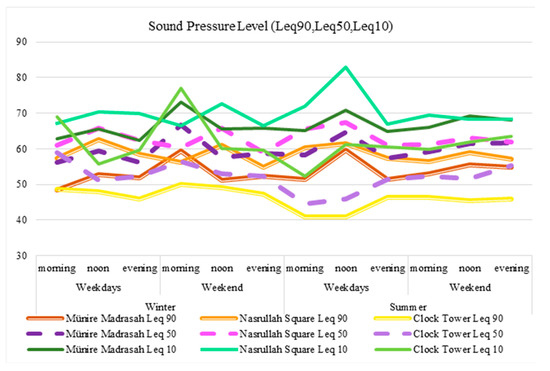
Figure 3.
Comparison of L10, L50, and L90 values.
3.3. Noise Maps
3.3.1. Münire Madrasah
The noise maps obtained through the measurements made with the NoiseCapture program installed on the smartphone along the walking route in the Münire Madrasah are given in Table 6. On the map, detected sound values lower than 55 dB (A) are represented in green and shades of green, whereas sound values higher than 55 dB (A) are in yellow, and values higher than 65 dB (A) in are in shades of red. It was observed that the sound levels increased at the points close to the shops in the Madrasa. It was found that there was an increase in the sound level due to the increase in the usage intensity in the space during the summer period. Due to the touristic character of the area and the presence of souvenir shops, the increase in the usage intensity on the weekend was observed at noon on weekdays, and the increase was also reflected in the sound level (Table 6). Due to the predominance of structural elements in the area, the effect of changes in natural characteristics (foliation of plants, wind effect, etc.) depending on climatic changes was not detected in sound level measurements.

Table 6.
Noise maps of Munire Madrasah.
3.3.2. Nasrullah Square
An effect of traffic noise caused by the main transport axis of the city located at the entrance to the Square was observed, especially at the entrance to the Square, at the point where the walks began and ended. When the maps created for the area are examined, it is seen that the red dots intensify due to the increase in sound intensity, especially at the points associated with the vehicle road. In addition, depending on the intensive human use in the square (it being a transit area and a worship area, and being surrounded by commercial structures, musical performances being held in the square, etc.), the sound level was determined to be high compared to other study areas, and since the majority of the sounds measured along the route were determined to be above 55 dB(A), they were expressed with red dots. Depending on the location of the Square in the city center, the intensity of use was approximately the same in summer and winter, so there was no seasonal difference, but in winter, the intensity of sound was found to be lower in the morning and evening measurements. Due to the predominance of structural elements in the area, the effect of changes in natural characteristics (foliation of plants, wind effect, etc.) owing to climatic change was not detected in the sound level measurements (Table 7).

Table 7.
Noise maps of Nasrullah Square.
3.3.3. Clock Tower
When the noise maps created according to the measurement results along the walking route in the Clock Tower were examined in terms of periodic change, it was observed that the sound intensity in the area was below 55 dB (A), although the sound intensity increased in the summer period. Despite the fact that the sound intensity was determined to be above 55 dB (A), especially in areas that are more used by people (the Clock Tower, seating areas, viewing points), the sound intensity was found to be lower than in other study areas due to the fact that the area itself and its surroundings were not subjected to intensive human use and that natural sounds (wind sound, bird sound, leaf sound) were dominant in the area (Table 8).

Table 8.
Noise maps of the Clock Tower.
4. Discussion
Within the scope of the conservation works carried out in historical areas, the area should, if possible, be protected with the old type of use, and if this is not possible, new land use decisions should be made to ensure sustainability. According to the UNESCO recommendation on the historic landscape, correctly managed historical areas can be used for tourism, accommodation, education, cultural, and social purposes. Such uses can provide economic income, and support the increase of the welfare level of societies, and preservation can be done at the same time [2]. In order to manage historical areas properly, source values need to be defined and protected. One of these source values is the historical sounds that emerge depending on the physical and cultural elements of the space [17,44]. Historical areas have their own unique sound characteristics. Depending on the purpose and characteristics of the area, these sounds sometimes appear as a prayer sound, sometimes as a bell sound, and sometimes as a siren sound. The sound features that have remained and/or disappeared today take listeners back in time and the characteristics of the place can be expressed through historical sounds [45]. From this point of view, the results of this study reveal that the sound sources have not changed due to the fact that there have not been many changes in the usage patterns of the selected areas in the historical process, and that the sound sources are fit for the purpose of use of the spaces and that the sound sources provide information about the spaces.
When the results of the studies on the acoustic environment of historical places and the results obtained in this study were evaluated, it was observed that human voice, sound of footsteps, sound of music, religious sounds, and traffic sounds were common sound sources. In addition, it was determined that the vast majority of the sounds detected in the study area were human-produced sounds. Urban historical sites are areas that have partially or completely lost their natural features over time, and in which the human element and therefore the human-derived sounds are at the forefront. Natural sound sources were not dominant in the space, as they often had sound intensities below the intensity of human-made sounds. As a matter of fact, the bird sound and water sound detected in Nasrullah Square remained behind the human-made sounds in the square, and could only be heard during periods when the usage intensity decreased. İsmail [8] states in his study that rain, birds, and other natural elements are preferred by users at high sound intensity. Therefore, in the regulations regarding the acoustic environment, attention should be paid not only to the use of natural sound sources, but also to the arrangement of sound intensities in a way that they do not remain behind human-produced sounds.
In studies conducted on the sound landscapes of historical areas, it was determined that common sound elements were in the forefront [1,6,46], but in all areas, the sound of traffic was found to have an adverse effect on the character of the area. Especially in urban areas, the general use of motor vehicles causes low-frequency sounds, causing permanent and continuous background noise [15]. In the study, as a result of the measurements made especially in Nasrullah Square, continuous background sounds from motor vehicles were detected due to the Square being adjacent to the vehicle road. The study by Yang and Kang [47] states that low-intensity background sounds lead users to be quieter. This can also be regarded as a condition of “effect and reaction”. As part of the study, it was observed that as the background sound intensity increased in Münire Madrasah and the Nasrullah Square, there was an increase in the intensity of human voices, especially due to difficulty hearing. In the Clock Tower, however, it was determined that users adapted to the quietness of the environment and used the space accordingly. Therefore, it is thought that taking measures to reduce background sounds, especially in historical places, can ensure that the sound intensity of the human voice in the space remains at a low level in parallel.
In addition, studies have shown that in order for a space to be preferred by users, it is necessary to pay attention not only to the low intensity of sound sources, but also to the presence of sound sources suitable for the character of that space [6,36,48,49,50]. As a matter of fact, it is believed that the fitting of sound sources with the purpose of using the space is effective when users continue to use the space intensively, despite the fact that the highest sound level is reached during periods of increased intensity of use in the Münire Madrasah. In addition, the point to be considered here is that human voice should be distinguished from human-produced sounds (traffic sound, mechanical sounds, etc.). According to the results of the study, it was determined that the human voice was dominant in the Madrasah, while the human-produced sounds were dominant in the Square and the intensity of the human-produced sounds was higher than that of the human voice. This situation is thought to be effective in the fact that the user density does not decrease despite the increasing sound intensity in the Madrasa.
The increase in intensity of use shows that sometimes the human voice reaches even more disturbing levels than the human-produced sounds. Especially due to population growth, the density of use of historical sites is steadily increasing. When intensive use of historical sites in urban centers for tourism purposes is added to this situation, sound levels reach undesirable levels and users are negatively affected by this situation as a consequence. Given that the three selected areas are also important touristic points of the city, the SPLs obtained through the study showed similarities with the SPLs by Kang et al. [51], which were performed at tourist spots in different cities in Europe and China (European cities (tourist spotMax: 80.7 dB(A); China (tourist spotMin: 49.3 dB(A)); Kastamonu (tourist spotMax: 81.1 dB(A), tourist spotMin: 56.2 dB(A)). On the one hand, tourists prefer areas with pleasant sound sources away from noise, while on the other hand, they themselves can be a source of noise [52]. Therefore, the acoustic environment in these areas should be improved [21,53,54]. In such areas, it is important that the acoustic environment is at a level and character that does not disturb users, so that the users can have fun and relax, but at the same time, the acoustic environment should not harm their health. The ‘‘quiet side concept’’ could help reduce adverse effects of road traffic noise and other undesired sound resources and promote healthier sound environments in historical urban areas. When the results of the study are examined, it can be stated that the long-term use of Nasrullah Square and Münire Madrasah may have a negative effect on the user experience and health, and they may be regarded as not having a healthy acoustic environment. The Clock Tower has a positive effect due to its quiet side concept. In addition, it was found that when groups of tourists arrived at the Münire Madrasah, the intensity of the human voice increased and suppressed other sounds in the space. Since this area is used as a place for marketing local crafts, visitors to the area focus directly on shopping, which may cause the information about the character of the place to be ignored. This should be considered as a sign that the purpose of use for such historical sites should be chosen very carefully. Another point is that these historical areas were previously dominated by the sounds of local people, and now more and more tourist voices have become dominant in these areas, and tourists’ voices have now begun to characterize them. It is important to note here that the dominance of these new sound features should not preclude the sound features of the past that characterize the space, and ensure that the sound features of the past do not disappear. Therefore, it is necessary to ensure that a sufficient number of tourists visit the place at a time, taking into account the carrying capacity of the places, whether it is a natural or a cultural place.
5. Conclusions
Cities lose their natural, cultural, and historical acoustic environment as a result of human activities. For this reason, it is necessary not only to control the sound in cities, but also to place sound sources in places that are preferred by users, or to pay attention to the protection of existing ones. In order to ensure sustainability, especially in historical sites, the surveys should be carried out not only on the detection and documentation of structural elements, but also on the detection and documentation of the sensory characteristics of the space. In this way, access to reliable information about the history of the space will be possible for urban spatial planning and design studies, and the choice of elements appropriate to the character of the space will be more accurate. At this point, in the arrangements to be made regarding the acoustic environment of historical urban areas, it is not enough, for a planner and designer to remove or camouflage unwanted sounds from the space, or to bring or highlight the desired sounds to the space. In addition, it is necessary to think carefully before eliminating the sound environment that people are used to. It should be noted that removing some of the sound sources that people use as a reference in their own daily lives may cause people to get lost in the space or have a feeling of being lost. At this point, it should not be ignored that the information and sound sources obtained, especially from historical sites, are of great importance for the continuation of the users’ sense of belonging. One of the important elements that supports the sense of belonging is the identity of the place. Today, efforts for spaces to have an identity or to protect their identities are among the main study areas of urban planning and design studies. In defining the identity of the space, it is important to identify the features that make up that identity, and one of these features is the sound sources that the space has. In historical areas in particular, the preservation of the identity of the space and as part of this, the harmony of sound sources with the identity of the space, are the issues that need to be overemphasized. While the sound sources in the space sometimes reveal a feature that is compatible with the characteristics of the space, sometimes they do not. Likewise, while sometimes the sounds in the space remain unchanged from past to present, sometimes they differ depending on the changes in living conditions.
In this context, the results obtained by this study showed that the sound sources and sound intensities of the study areas are compatible with the characteristics of the space, and that the sound sources have also not changed as spatial uses have remained unchanged.
The Münire Madrasah, one of the study areas, was originally built as an educational institution. Although it is used as a commercial unit today, it has been determined that the old and new sound sources have not changed, and the sound source that characterizes the Madrasah is the human voice. Due to the dominance of structural elements in the Madrasah, natural sound sources were not detected. Therefore, it was found that there were no differences in sound sources due to seasonal changes, but that the temporal changes caused the sound levels of the Madrasah to change since they altered the intensity of use of the Madrasah. The way the Nasrullah Square is used today and, in the past, has remained unchanged. The Square is located in the center of the city and in the middle of an area where historical sites are heavily visited by locals and tourists, and it contains a religious structure surrounded by commercial units and recreational areas. This is the reason why human-produced sounds are dominant in the Square. Due to the religious structure and the fountain, which are the main reason for the formation of the Square, it is thought that the sound that characterizes the area is the sound of prayer and water, although human-produced sounds (traffic sound, human speech, human footsteps) are also dominant. It was found that natural sounds are dominant depending on the location of the Clock Tower and its low-intensity use, and since the history of the resting area around the Tower goes back to the early 2000s, human-produced sounds have been determined to increase in the area afterwards. It can be stated that the sound that characterizes the Clock Tower is the sound of the bell ringing in the tower as well as natural sounds.
According to the SPL measurement results performed in the study areas, although the values were determined to be above the 55 dB(A), a value recommended by the WHO, it was also observed that they did not reach the level that would harm humans (70 dB(A)) for prolonged periods of time. If an auditory comfort assessment is performed in selected areas, it can be noted that the Clock Tower in particular has the appropriate SPL (average Leq 61 dB(A)). Since SPL measurements at the Nasrullah Square (average Leq 67 dB(A)) and the Münire Madrasah (average Leq 65 dB(A)) were determined to be above the level recommended by WHO, efforts should be made to reduce the sound intensity in these two areas. In order to reduce the high level of sound intensity caused by vehicle traffic detected in the Nasrullah Square, it may be recommended to increase the intensity of roadside planting, especially the use of plants with frequent branch structure and foliation. In addition, while there are natural sound sources, such as bird sounds and rushing-water sounds, in the area, preventing these sounds from being drowned out by human-produced sounds will also ensure that the Square is especially preferred by those who come for the purpose of relaxing and sightseeing. Previous studies have shown that natural sound sources are preferred by users [8,55,56]. Therefore, arrangements should be made to highlight the natural sound sources present in the area, and the traffic noise should be suppressed as much as possible. Considering the purpose of its use, the intensity of the human-produced sounds in the Münire Madrasah can be reduced by allowing a certain number of users to enter the area, and at the same time, by intensifying the vegetation in the courtyard of the Madrasa, the sound intensity will decrease. The Clock Tower is one of the areas where natural sounds can be heard without being drowned out by human voices, and thus construction should not be allowed around it in order to maintain this feature. The Clock Tower, which allows people to experience natural sounds in the city and also to visually monitor the city, was also found to be different from the other two areas, with sounds below 55 dB(A) for 90% of the measurement time.
To conclude, the results of the study reveal that the acoustic characters of historical sites are affected by the usage type, user density, structural and vegetative density, and climatic characteristics of the areas. Although sound pressure level measurements varied throughout the year, their spatial distribution was observed to be the same when associated with space. For this reason, it has been concluded that the types of use in spaces are the primary element that affects the sound pressure level. In addition, sounds (such as traffic) associated with background uses that affect the character of the space have also been found to affect the auditory comfort of the space. In this sense, necessary structural and vegetal screens should be made to prevent or reduce unwanted sounds. It has been revealed in the Münire Madrasah and the Nasrullah Square that another factor, the user density, is effective in shaping the acoustic character. In this respect, the number of potential users per unit area should be taken into account for each use. When the structural and vegetative density in the study areas were evaluated, it was determined that the effect of speech and footsteps in particular is felt more in the space, depending on the scarcity of vegetal material and the density of structural elements in the Madrasah and the Square. For this reason, the use of structural materials that can absorb the sound in the space and also the intensive use of vegetal material will reduce this folding sound effect in the space. The climate change factor has an effect on the sound intensity and the diversity of sound sources. As a matter of fact, the foliation that occurs in plants due to climatic changes in the Nasrullah Square enables the bird sound to come into play as a different source from other sound sources. Likewise, the atmospheric sounds detected in the Clock Tower also emerged due to climatic changes. For this reason, by taking the climatic changes that affect the acoustic character as well as other factors into consideration, an acoustic environment should be created in historical sites and be preserved as an element of cultural heritage.
The results of the study reveal that sound level measurements and related noise maps should be used in the planning and design of historical areas, as they contain detailed information about these areas. It is thought that considering these data in the studies to be carried out on historical sites will be useful for making the right decisions and will guide future studies.
Author Contributions
Conceptualization, N.B. and I.K.; methodology, N.B. and I.K.; software, N.B.; validation, I.K.; formal analysis, N.B.; investigation, N.B.; resources, I.K.; data curation, N.B.; writing—original draft preparation, N.B. and I.K.; writing—review and editing, N.B.; visualization, N.B.; supervision, N.B.; project administration, N.B.; funding acquisition, I.K. All authors have read and agreed to the published version of the manuscript.
Funding
This research was funded by KASTAMONU UNIVERSITY COORDINATORSHIP OF SCIENTIFIC RESEARCH PROJECTS, Grant number KUBAP-04/2016-2 and The APC was funded by Nur Belkayalı.
Institutional Review Board Statement
Not applicable.
Informed Consent Statement
Not applicable.
Data Availability Statement
The data that support the findings of this study are available from the corresponding author, upon reasonable request.
Acknowledgments
This study was supported by Kastamonu University Coordinatorship of Scientific Research Projects (Grant number KUBAP-04/2016-2).
Conflicts of Interest
The authors declare no conflict of interest.
References
- Brambilla, G.; Maffei, L. Perspective of the soundscape approach as a tool for urban space design. Noise Control. Eng. J. 2010, 58, 532–539. [Google Scholar] [CrossRef]
- UNESCO. Recommendation on the Historic Urban Landscape. Available online: https://whc.unesco.org/uploads/activities/documents/activity-638-98.pdf (accessed on 18 June 2021).
- UNESCO. Intangible Cultural Heritage. Available online: https://www.unesco.org.tr/Pages/52/19/Somut-Olmayan-K%C3%BClt%C3%BCrel-Miras-%C4%B0htisas-Komitesi (accessed on 18 June 2021).
- Garrioch, D. Sounds of the city: The soundscape of early modern European towns. Urban. Hist. 2003, 30, 5–25. [Google Scholar] [CrossRef] [Green Version]
- Liu, J.; Kang, J.; Luo, T.; Behm, H.; Coppack, T. Spatiotemporal variability of soundscapes in a multiple functional urban area. Landsc. Urban. Plan. 2013, 115, 1–9. [Google Scholar] [CrossRef]
- Huang, L.; Kang, J. The sound environment and soundscape preservation in historic city centers-the case study of Lhasa. Environ. Plan. Plan. Des. 2015, 42, 652–674. [Google Scholar] [CrossRef]
- Ge, J.; Hokao, K. Applying the methods of image evaluation and spatial analysis to study the sound environment of urban street areas. J. Environ. Psychol. 2005, 25, 455–466. [Google Scholar] [CrossRef]
- Ismail, M.R. Sound preferences of the dense urban environment: Soundscape of Cairo. Front. Archit. Res. 2014, 3, 55–68. [Google Scholar] [CrossRef] [Green Version]
- Dubois, D.; Guastavino, C.; Raimbault, M. A cognitive approach to urban soundscapes: Using verbal data to access everyday life auditory categories. Acta Acust. United Acust. 2006, 92, 865–874. [Google Scholar]
- Adams, M.; Cox, T.; Moore, G.; Croxford, B.; Refaee, M.; Sharples, S. Sustainable soundscapes: Noise policy and the urban experience. Urban. Stud. 2006, 43, 2385–2398. [Google Scholar] [CrossRef]
- Yu, L.; Kang, J. Factors influencing the sound preference in urban open spaces. Appl. Acoust. 2010, 71, 622–633. [Google Scholar] [CrossRef] [Green Version]
- Zhang, M.; Kang, J. Towards the evaluation, description and creation of soundscapes in urban open spaces. Environ. Plan. Plan. Des. 2007, 34, 68–86. [Google Scholar] [CrossRef]
- WHO. Guidelines for Community Noise, Edited by Birgitta Berglund, Thomas Lindvall, Dietrich H Schwela; World Health Organization: Geneva, Switzerland, 1995. [Google Scholar]
- Cain, R.; Jennings, P.; Adams, M.; Bruce, N.; Carlyle, A.; Cusack, P.; Davies, W.; Hume, K.; Plack, C.J. Sound-Scape: A framework for characterising positive urban soundscapes. J. Acoust. Soc. Am. 2008, 123, 3394. [Google Scholar] [CrossRef]
- Raimbault, M.; Dubois, D. Urban soundscapes: Experiences and knowledge. Cities 2005, 22, 339–350. [Google Scholar] [CrossRef]
- Brown, A.L.; Muhar, A. An Approach to the acoustic design of outdoor space. J. Environ. Plan. Manag. 2004, 47, 827–842. [Google Scholar] [CrossRef] [Green Version]
- Zuo, L.; Zhang, J.; Zhang, R.J.; Zhang, Y.; Hu, M.; Zhuang, M.; Liu, W. The transition of soundscapes in tourist destinations from the perspective of residents’ perceptions: A case study of the Lugu Lake Scenic Spot, Southwestern China. Econ. Lit. 2020, 12, 1073. [Google Scholar] [CrossRef] [Green Version]
- Schafer, R.M. The Soundscape: Our Sonic Environment and the Tuning of the World; Destiny Books: Rochester, VT, USA, 1993. [Google Scholar]
- Tsai, K.T.; Lin, M.; Chen, Y.H. Noise mapping in urban environments: A Taiwan study. Appl. Acoust. 2009, 70, 964–972. [Google Scholar] [CrossRef]
- Guastavino, C. The ideal urban soundscape: Investigating the sound quality of French Cities. Acta Acust. United Acust. 2006, 92, 945–961. [Google Scholar]
- Li, R.; Ou, D.; Pan, S. An improved service quality measurement model for soundscape assessment in urban public open spaces. Indoor Built Environ. 2020, 1420326X20925527. [Google Scholar] [CrossRef]
- Brambilla, G.; De Gregorio, L.; Maffei, L.; Can, Z.Y.; Ozcevik, A. Comparison of the Soundscape in the Historical Centers of Istanbul and Naples in Proceedings of Inter-Noise07; Institute of Noise Control Engineering: Istanbul, Turkey, 2007; pp. 2640–3477. [Google Scholar]
- Zhou, Z.; Kang, J.; Jin, H. Factors that influence soundscapes in historical areas. Noise Control. Eng. J. 2014, 62, 60–68. [Google Scholar] [CrossRef]
- Djimantoro, M.I.; Martokusumo, W.; Poerbo, H.W.; Sarwono, R.J. The historical soundscape analysis of Fatahillah Square, Jakarta. Acoustics 2020, 2, 847–867. [Google Scholar] [CrossRef]
- Kastamonu Municipality. Kastamonu Zoning Plan; Modul Planning: Kastamonu, Turkey, 1996. [Google Scholar]
- Guloglu, Y.; Bulut, A.; Altunel, A.O.; Bayramoglu, M.M. The effect of population shift on land cover change and illegal forest activities. Environ. Monit. Assess. 2021, 193, 1–13. [Google Scholar] [CrossRef]
- Turkish Statistical Institute. Kastamonu Central District Population. Available online: https://www.nufusune.com/kastamonu-nufusu (accessed on 10 June 2020).
- KDCT. Kastamonu Province Tourist Statistics. Kastamonu Provincial Directorate of Culture and Tourism. Available online: https://www.kastabil.gov.tr/veritablolari/kastamonu/kultur-ve-turizm/kultur-ve-turizm-bakanligi-na-bagli-muze-ve-oren-yerlerinin-ziyaretci-sayisi-ve-geliri (accessed on 18 June 2021).
- Yıldız, T. Kastamonu Central District Analysis; North Anatolian Development Agency: Kastamonu, Turkey, 2013. Available online: https://www.kuzka.gov.tr/Icerik/Dosya/www.kuzka.gov.tr_16_PO2G10AN_kastamonu_merkez_ilce_analizi.pdf (accessed on 10 June 2020).
- KDCT. Civil Architecture and Mansions. Kastamonu Provincial Directorate of Culture and Tourism. Available online: https://kastamonu.ktb.gov.tr/TR-63867/tarihi-evler-ve-konaklar.html (accessed on 10 June 2020).
- KDCT. Kastamonu Münire Medresesi, Kastamonu Provincial Directorate of Culture and Tourism. Available online: https://kastamonu.ktb.gov.tr/TR-95228/munire-medresesi-el-sanatlari-carsisi.html (accessed on 10 June 2020).
- KDCT. Nasrullah Square. Kastamonu Provincial Directorate of Culture and Tourism. Available online: https://kastamonu.ktb.gov.tr/TR-93960/nasrullah-kadi-kulliyesi.html (accessed on 10 June 2020).
- KDCT. Kastamonu Clock Tower. Kastamonu Provincial Directorate of Culture and Tourism. Available online: https://www.kulturportali.gov.tr/turkiye/kastamonu/gezilecekyer/saat-kules528735 (accessed on 10 June 2020).
- Koç, M. The Relationship Status in Kastamonu after World War I–II. Available online: https://www.kastamonur.com/1-dunya-savasi-sonrasi-kastamonuda-asayis-durumu-ii/ (accessed on 10 June 2020).
- Ugurlukonaklari. Past of Kastamonu. Available online: https://ugurlukonaklari.com/galeri-2/ (accessed on 10 June 2020).
- Szeremeta, B.; Zannin, P.H.T. Analysis and evaluation of soundscapes in public parks through interviews and measurement of noise. Sci. Total. Environ. 2009, 407, 6143–6149. [Google Scholar] [CrossRef]
- Stimac, A. Implementation of Directive 2002/49/EC in EU Candidate State: Experience in Croatian Noise Mapping Projects. Forum Acusticum Budapest 2005, L53–L58. Available online: https://www.researchgate.net/profile/Alan-Stimac/publication/228479304_Implementation_of_Directive_200249EC_in_EU_Candidate_State_Experience_in_Croatian_noise_mapping_projects/links/57dbce7c08aeea195934f2c1/Implementation-of-Directive-2002-49-EC-in-EU-Candidate-State-Experience-in-Croatian-noise-mapping-projects.pdf (accessed on 12 June 2020).
- Maffei, L. Urban and Quiet Areas Soundscape Preservation. In Proceedings of the VI Congreso Iberoamericano de Acustica FIA 2008, Buenos Aires, Argentina, 5–7 November 2008. [Google Scholar]
- Akpınar, N.; Belkayalı, N.; Kaymaz, I.; Turan, F.; Büyükşahin, S.A.; Oğuz, D. The Perception of Soundscape and User Preferences in Urban. Parks within the Scope of Quality of Life: Ankara Sample, Tubitak Project Result Report no.110Y186; The Scientific and Technological Research Council of Turkey: Ankara, Turkey, 2013. [Google Scholar]
- Bocher, E.; Petit, G.; Picaut, J.; Fortin, N.; Guillaume, G. Collaborative noise data collected from smartphones. Data Brief. 2017, 14, 498–503. [Google Scholar] [CrossRef]
- Schulte-Fortkamp, B.; Lercher, P. The Importance of Soundscape Research for the Assessment of Noise Annoyance at the Level of the Community, TecniAcustica, Bilbao. 2003. Available online: http://www.sea-acustica.es/fileadmin/publicaciones/Bilbao03_aam008.pdf (accessed on 12 June 2020).
- GDEM. Environmental Noise Measurement and Evaluation Guide; General Directorate of Environmental Management: Ankara, Turkey, 2011. [Google Scholar]
- Guillaume, G.; Can, A.; Petit, G.; Fortin, N.; Palominos, S.; Gauvreau, B.; Bocher, E.; Picaut, J. Noise mapping based on participative measurements. Noise Mapp. 2016, 3, 140–156. [Google Scholar] [CrossRef] [Green Version]
- Carles, J.L.; Barrio, I.L.; de Lucio, J.V. Sound influence on landscape values. Landsc. Urban. Plan. 1999, 43, 191–200. [Google Scholar] [CrossRef]
- Firstcom Music. Historical Music for Productions. Available online: https://www.firstcom.com/en-us/explore/music-for/historical (accessed on 19 June 2021).
- Barrigón Morillas, J.M.; Gómez Escobar, V.; Rey Gozalo, G. Noise source analyses in the acoustical environment of the medieval centre of Cáceres (Spain). Appl. Acoust. 2013, 74, 526–534. [Google Scholar] [CrossRef]
- Yang, W.; Kang, J. Acoustic comfort evaluation in urban open public spaces. Appl. Acoust. 2005, 66, 211–229. [Google Scholar] [CrossRef]
- Nilsson, M.E.; Berglund, B. Soundscape quality in suburban green areas and city parks. Acta Acust. United Acust. 2006, 92, 857–864. [Google Scholar]
- Tardieu, J.; Susini, P.; Poisson, F.; Lazareff, P.; McAdams, S. Perceptual study of soundscapes in train stations. Appl. Acoust. 2008, 69, 1224–1239. [Google Scholar] [CrossRef] [Green Version]
- Cassina, L.; Fredianelli, L.; Menichini, I.; Chiari, C.; Licitra, G. Audio-Visual Preferences and Tranquillity Ratings in Urban Areas. Environments 2018, 5, 1. [Google Scholar] [CrossRef] [Green Version]
- Kang, J.; Yang, W.; Zhang, M. Sound environment and acoustic comfort in urban spaces. In Design Open Spaces in the Urban Environment: A Bioclimatic Approach; Nikolopoulou, M., Ed.; Centre for Renewable Energy Sources, EESD, FP5: Attiki, Greece, 2004; pp. 32–36. [Google Scholar]
- Yi, C.; Huang, C. Residents’ perception and attitude of the tourism impact of the Global Dinosaur Town in Changzhou City. Geogr. Res. 2013, 32, 1165–1176. [Google Scholar]
- Jennings, P.; Cain, R. A framework for improving urban soundscapes. Appl. Acoust. 2013, 74, 293–299. [Google Scholar] [CrossRef] [Green Version]
- Kang, J. From environmental noise control to soundscape design. Int. J. Acoust. Vibr. 2015, 20, 62. [Google Scholar]
- Buxton, R.T.; Pearson, A.L.; Allou, C.; Fristrup, K.; Wittemyer, G. A synthesis of heaty benefits of natural sounds and their distribution in national parks. Proc. Natl. Acad. Sci. USA 2020, 118, 1–6. [Google Scholar] [CrossRef]
- Zhang, Y.; Kang, J.; Kang, J. Effects of soundscape on the environmental restoration in urban natural environments. Noise Health 2017, 19, 65–72. [Google Scholar] [CrossRef] [PubMed]
Publisher’s Note: MDPI stays neutral with regard to jurisdictional claims in published maps and institutional affiliations. |
© 2021 by the authors. Licensee MDPI, Basel, Switzerland. This article is an open access article distributed under the terms and conditions of the Creative Commons Attribution (CC BY) license (https://creativecommons.org/licenses/by/4.0/).
